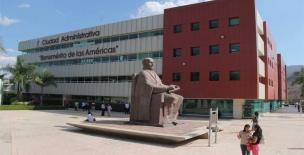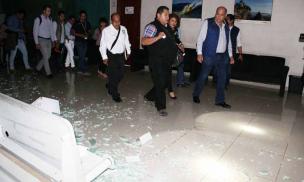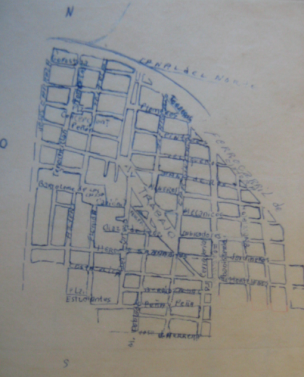
Dec 15, 2017 |
Chris Gatto, PhD Candidate, History
On Thursday, September 7, 2017, a magnitude 8.1 earthquake struck off the Pacific coast of Mexico, killing over 100 individuals and damaging thousands of homes in the southern states of Chiapas, Oaxaca, and Tobasco. This was the strongest earthquake the country had experienced since 1787. While earthquakes are a fairly common occurrence in Mexico, this particular event caused more alarm and destruction than could have ever been anticipated.
The earthquake struck at approximately 11:30 pm, and I acutely remember standing in the bathroom of my Airbnb in Oaxaca City, brushing my teeth and getting ready to go to bed. I was concluding nearly two months of archival research in Oaxaca for my dissertation, entitled “From Cochineal to Coffee: The Making of a New Rural Society in Miahuatlán, Oaxaca, 1780–1880.” The door to my small apartment began to shake violently, and my initial thought was that someone was trying to break in. As I walked over to see what was happening, I immediately fell to the ground, as the floor beneath me began to shake. The power in the city then went out, and in complete darkness it became all too clear to me and everyone else in the city what was occurring.
While my first thought was to text my anxious mother (before she uncovered the news of the earthquake on her own), I then began to consider how this would affect the work I still needed to get done. I was finishing nearly six weeks of research in the Archivo Histórico de Notarías, a vast archive inside the Church of Santo Domingo right in the heart of Oaxaca City. This archive is home to nearly 2,000 volumes of notarial documents from the early 17th century all the way up until the 20th century, including land purchases and rentals, wills, contracts, and inventories. Needless to say, this archive plays an essential role in my dissertation, which explores the dramatic agricultural transformation that occurred in the southern part of the state from cochineal to coffee cultivation over the course of the 19th century.
The Archivo Histórico de Notarías is now fully digitalized, but researchers still need to spend considerable amounts of time with the original documents, identifying book and page numbers before proceeding to the Dirección General de Notarías, an office located in the Ciudad Administrativa about 15 minutes outside of the city, to begin a complicated process (trámite) of requesting digital copies. While I knew the Archivo itself would be closed for several days (as it was, although thankfully with limited damage), I was also concerned about the Ciudad Administrativa, where I needed to travel with a flash drive to collect all the images I had been identifying over the past month.
-

-
The main square of the Ciudad Administrativa on an average day
-

-
Ciudad Administrativa after the earthquake
-

-
Ciudad Administrativa after the earthquake
The first image above depicts the main square of the Ciudad Administrativa on an average day, while the next two images reflect the damage suffered following the earthquake. Suffice it to say, these offices would not reopen for quite some time, as government workers refused to return to the campus until proper working conditions had been restored. I remember visiting the Ciudad Administrativa during that week, hoping I could find someone, anyone, that could help me gain access to the hard drive and expedite the transfer of images. However, I was promptly turned away, as they insisted I would have to return the following week. Unfortunately, I did not have another week, and I flew back to Chicago on September 16 with the sick feeling that so much time and effort had been expended for nothing. While I was determined to return to Oaxaca soon to complete my research, I knew there were further challenges I would eventually have to overcome…
-

-
Protests at the Ciudad Administrativa
-

-
Protests at the Ciudad Administrativa
The Ciudad Administrativa, along with the Ciudad Judicial, are the two largest government offices in Oaxaca. However, on any given day, access to these offices is severely restricted, since they become the site for a range of protests from different social organizations and unions across the region, including taxi drivers (taxistas), teachers’ unions (maestros), and indigenous rights activists. These groups block access to the Ciudad Administrativa in different and often inventive ways (as shown in the images above), and when this happens, nobody can enter or leave the campus until the groups disassemble. These protests have become so routine that the public has become accustomed to the disruptions and adjust their schedules accordingly. Whatever one thinks of the validity of these protests (I happen to be quite sympathetic), they cause significant disturbances in the life of ordinary residents in the city, and you will often hear people expressing sympathy for the causes but not necessarily the tactics.
In organizing my trip back to Oaxaca, I knew I would have to allow several days for a procedure that should only take a couple hours. On the week of October 23, 2017, I flew back to Oaxaca, allowing five days (Monday through Friday) to get my work completed. I anxiously checked my Twitter feed on an hourly basis to identify reports of potential blockades (bloqueos) at the government campus. As it turns out, I was able find a small window early Tuesday morning to enter the Ciudad Administrativa and complete the process of acquiring nearly 1,000 images that will hopefully form an important part of my dissertation. Shortly after I entered, the campus was closed off, and we could not leave until 6pm that evening. The campus experienced similar protests on Wednesday, Thursday, and Friday of that week, and thus I was incredibly fortunate to find the small window that I did to get my work completed.
Researchers in Mexico and across Latin America face these types of logistical challenges on a regular basis, and I do not mean to suggest that what I have faced is unique or atypical in any way. But my work in Oaxaca does show how precarious the work of historians can be, given that we are forced to rely on documents that readily become available or unavailable according to shifting circumstances beyond our control. I hope my dissertation can make good use of the materials I have been lucky enough to uncover, and shed light on historical processes that help us better understand such a dynamic and important region of Mexico.

Nov 2, 2015 |
By Emilio de Antuñano, Ph.D. Candidate, Department of History
My dissertation studies Mexico City’s growth in the years between 1930 and 1950, analyzing how different groups shaped the transformation of Mexico’s capital and—perhaps more significantly—were shaped by it. These questions first led me to Mexico City’s municipal archives, where I spent months looking at documents that recorded the conflicts between urban planners, government officials, political brokers, and associations of urban residents at a time of unforeseen urban growth. For the most part, these documents seemed bureaucratic and dry, in stark contrast with the boisterous corner of the streets of Cuba and Chile where the Archivo Histórico de la Ciudad de México stands. The movement and the noises of the street offered a reminder of life, a life which I was unable to find amidst the dusty papers of the archive, particularly during the initial months of my research.
This past summer, my research took me to a very different site, only two hours away from Chicago: the Library of the University of Illinois at Urbana-Champaign, where the Oscar and Ruth Lewis Papers are located. Trained as an anthropologist, Oscar Lewis wrote extensively about small, “traditional” communities, cities, and the migration from one to the other that so deeply transformed the twentieth century. Ruth Lewis, a psychologist, conducted research alongside her husband, often gaining entrance into domestic spheres closed to him. Most significantly for my own research, Oscar and Ruth Lewis spent the larger part of the 1950s in Mexico City, studying the culture of the poor in Mexico’s infamous vecindades; two books—Five Families (1959) and Children of Sánchez (1961)—are the direct outcome of this research. The Oscar and Ruth Lewis Papers hold a trove of wonderful ethnographic material: interviews, life histories, photographs, statistics, and detailed descriptions of some of Mexico City’s neighborhoods. As a whole, these materials provide a unique window into the life of Mexico City’s poor residents at the time.
Lewis travelled to Mexico City in 1951, after conducting extensive fieldwork in Tepoztlán. His findings there challenged the traditional, homogenous, and static community that anthropologist Robert Redfield had theorized through his concept of the “folk society.” Instead of stability and harmony, Lewis discovered a town rife with conflict and change, as illustrated by the migration to Mexico City. “I want to study the influence of “city people” [migrants from Tepoztlán in Mexico City] on Tepoztlán and vice-versa,” wrote Lewis in 1944 while explaining his new project to Ernest Maes. “Furthermore, Mexico City now has a population of about two million. Of these at least a million are from the out-skirts, from rural areas. In this sense the colony of Tepoztecans may be representative of many country people who came to Mexico. We should know what happens to these people when they come to the city.” (1)
Lewis’ papers illuminate how his experience in Tepoztlán—as an anthropologist studying a “primitive” culture—shaped the questions that he posed to Mexico City. There, Lewis conducted most of his research in a few blocks of Colonia Morelos, a universe that in his writings appears as self-contained and that he would get to know intimately. This vantage point is crucial for understanding his ideas; although many of the people that he met led lives full of adventure and movement—migrating from Mexico City to the United States, or from Tepoztlán to Mexico City—reading his books it sometimes seems that they always came back to the streets of Colonia Morelos, crossed by kinship ties. Based on this vantage point, Lewis argued that migrants in Mexico City did not suffer from the loneliness and alienation that sociologists expected but, on the contrary recreated relationships that could be traced back to their towns of origin.
The transcripts of The Children of Sánchez are, arguably, the highlight of the archive. This book is divided in four parts, each of them telling the story of one of Jesús Sánchez’s four children—Jesús’ own life story opens and closes the book. The book is written from a first-person perspective, extracted from the hundreds of hours of interviews that Oscar, Ruth, and their research assistants conducted. Woven together, these stories provide an extremely layered and nuanced history of a family (the reader gets, for instance, four or five viewpoints of significant events in the family history). Lewis claimed that he chose his informants based on their talent as storytellers and their fascinating lives but his presence in the transcripts of the interviews is evident. By interviewing the Sánchez, befriending them, and editing their voices, Lewis wrote a book that resembles a novel—this is not incidental, he discussed literary matters with John Steinbeck and took the Sánchez to an O’Neill play, in order to “help them see the level” he was after (2). The lines between art and method, fiction and social science, are very hard to draw.
These meditations struck me as I read the transcripts of Lewis’s long interviews with the Sánchez and realized that they do not include the names featured in the book—Jesús, Manuel, Roberto, Consuelo, and Marta Sánchez—but, rather, the “real” names of the people whose lives the book so intimately describes. (The names were changed to protect the identity of the family, mostly a futile measure, as some of the “Sánchez” embraced the limelight and acquired relative fame). Reading these names stirred me; they seemed capable of bringing me one step closer to the past. And this feeling only grew, becoming almost unbearable, when I discovered a folder with photographs of the “Sánchez.” Lewis was a marvelous photographer. He looked at his subjects as equals and friends, without distance or condescension. The portraits seemed familiar, as if picturing someone we knew, as if the camera was not betraying the people in the book. The relationship between words in print and images was uncanny.
Viewing these photographs represented a deeply touching experience. It was, in many ways, the reverse of my earlier experience at the Archivo Histórico de la Ciudad de México. Urbana-Champaign is a quiet and bucolic college town; Lewis’ archive is located around its southern fringe, in a library annex by a park that gently transforms into an endless landscape of cornfields. Nothing could be further apart from the busy corner of the streets of Cuba and Chile—or from the streets that Lewis described and photographed. Life seemed richer within the archive this time, amidst the papers and photographs.
 Sketch of Colonia Morelos. Unknown author. Oscar and Ruth Lewis Papers, 1944–1967. “Peluqueros Census Data” (1956). Box 124.
Sketch of Colonia Morelos. Unknown author. Oscar and Ruth Lewis Papers, 1944–1967. “Peluqueros Census Data” (1956). Box 124.
Footnotes
(1) March 9, 1944. Quoted in Susan M. Rigdon, The Cultural Facade: Art, Science, and Politics in the Work of Oscar Lewis (Urbana: University of Illinois Press, 1988), 198.
(2) Oscar to Ruth Lewis. July 1957. The Cultural Facade, 219.
Please note:
The contents of this blog do not necessarily reflect the views of the Center for Latin American Studies or the University of Chicago.








 Sketch of Colonia Morelos. Unknown author. Oscar and Ruth Lewis Papers, 1944–1967. “Peluqueros Census Data” (1956). Box 124.
Sketch of Colonia Morelos. Unknown author. Oscar and Ruth Lewis Papers, 1944–1967. “Peluqueros Census Data” (1956). Box 124.